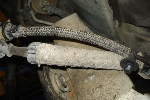yob_yeknom
Moderator Emeritus
- Joined
- November 14, 2000
- Messages
- 4,361
- Reaction score
- 0
- City, State
- Glade Hill, Virginia
- Year, Model & Trim Level
- '97 XLT & '06 Limited
Nope. Both my '97 and '01 have dipsticks and the 5R55E.
I have a similar problem to yours. Reverse started slipping but worked fine in drive. Then it started to slip in drive. I don't have a flashing light, so no codes. I parked it for a couple of months and I pulled it into the garage and everything worked fine, but the fluid is burnt. The o-rings around the low/reverse servo seem fine and the band feels springy when pushed with a screwdriver. All of the solenoids' resistances are within spec. I don't have a pressure gauge so I didn't check pressures before dropping the pan.
I have a similar problem to yours. Reverse started slipping but worked fine in drive. Then it started to slip in drive. I don't have a flashing light, so no codes. I parked it for a couple of months and I pulled it into the garage and everything worked fine, but the fluid is burnt. The o-rings around the low/reverse servo seem fine and the band feels springy when pushed with a screwdriver. All of the solenoids' resistances are within spec. I don't have a pressure gauge so I didn't check pressures before dropping the pan.












